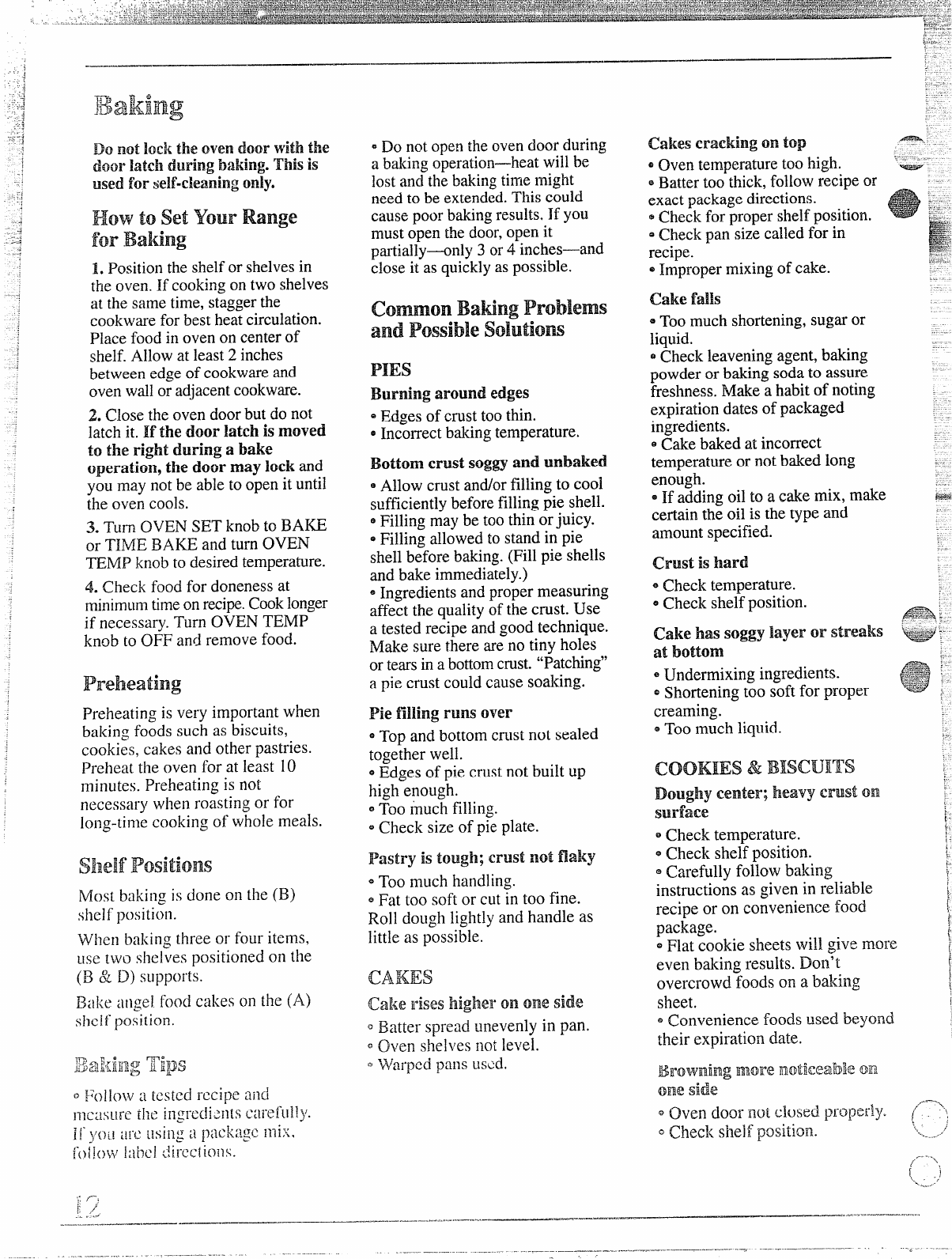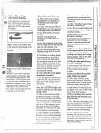
..
Do notlock the oven door with the
door Iatcllduring baking.This
is
used forself-cleaningonly.
How tosetYourRange
forBaIiiHg
1. Positionthe shelfor shelvesin
the oven. If cookingon two shelves
at the same
time,staggerthe
cookware for best heat circulation.
Place food in oven on centerof
shelf. Allow at least2 inches
between edge of cookwareand
oven wall or adjacentcookware.
2. Close the oven door but do not
latch it. If the door latch is moved
to the right during a
bake
operation, the door may lock and
you may not be ab~eto open it until
the oven cools.
3. Turn OVEN SET knob to BAKE
or TIME BAKE and turn OVEN
TEMP knob to desiredtemperature.
4. Check food for doneness at
minimumtimeonrwipe. Cooklonger
if necessary. Turn OVEN T_EMP
knob to OFF and remove food.
Preheating
Preheating is very important when
baking foods such as biscuits,
cookies, cakes and other pastries.
Preheat the oven for at least 10
minutes. Preheating is not
necessary when roasting or for
long-time cooking of whole meals.
ShelfPositions
Most baking is done on the (B)
shelf positit~ll.
When baking three or four items,
use two shelves positioned on the
(B & D)
SLl~pOFtS.
B:)k~ ;inge]
food cakes on the (A)
shelf position.
‘/-”%
1“ /’
~ . ...
-——...—-.----— —————-
_—
~Do not open theoven door during
a baking operation—heatwill be
lost
ancl thebakingtime might
need to be extended.This could
cause poor bakingresults.If you.
must open the door,open it
partially---only3 or 4 inches—a~~d
close it as quicklyas possible.
Comon Bating Problems
and Possible solutions
PIES
Burning around edges
*Edges of crust too thin.
~Incorrectbaking temperature.
BottonJIcrust soggy
and unbaked
~
Allow crust and/orfilling to cool
sufficientlybeforefilling pie shell.
~Filling may be too thin orjuicy.
e Filling allowed to stand in pie
shell before baking. (Fill pie shells
and bake immediately.)
@Ingredientsand proper measuring
affect the quality of the crust. Use
a tested recipe and good technique.
Make sure there are no tiny holes
or tearsin a bottomcrust.“Patching”
a pie crust could cause soaking.
Pie filling runs over
@Top and bottom crust not sealed
together well.
e Edges of pie crust not built up
high
enough.
e
Too Inuch filling.
*Check size of pie plate.
Pastry is tough; Crust not flaky
*Too much handling.
~Fat too soft or cut in too fine.
Roll dough lightly and handle as
little as possible.
CAKES
Cai<erises higher on one side
~Batter spread unevenly in pan.
Qoven shelves not leve].
~w,l]-ped
~~llS used.
Cakes cracking on top
@
Oven temperaturetoo high.
~Battertoo thick,followrecipe or
exact packagedirections.
~Check for proper shelf position.
--
“--!
~Check pan size called for in
E
A
_
-
recipe.
m,,
_....
-. .
.
~Impropermixingof cake.
..—
~Too much shortening,sugar or
liquid.
~Check leavening agent,baking
powder or baking soda to assure
freshness. Make a habit of noting
expirationdates of packaged
ingredients.
~Cake baked at incorrect
temperature or not baked long
enough.
~If adding oil to a cake mix, make
certain the oil is the type and
amount specified.
Crust ishard
~Check temperature.
~Check shelf position.
Cakehas soggy layer or streaks
at bottom
~Undermining ingredients.
~Shortening too soft for proper
creaming.
QToo much liquid.
COOKIES& BISCUITS
Doughy center;heavy crust on
surface
~Check temperature.
~Check shelf position.
~Carefully follow baking
instructions as given in reliable
recipe or on convenience food
package.
~Flat cookie sheets will give more
even baking results. Do~~’t
overcrowd foods on a baki~~g
sheet.
~Convenience foods used beyond
their expiration date,
—=.——....-.——...—.,.,.....—.......
——.. .. .....—
-a. .-.-.-m ..-- ..,— .,.--,


















